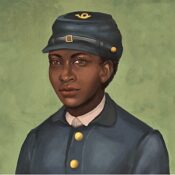It’s certainly strange what a few years will do to the way you feel about living and dying, not only about yourself but about others. What shows that up best is the brash way I felt and acted about the flu murder that terrible fall of 1918, compared to my fear of the threat of it now. In France in the fall of the last year of the War, the flu was just beginning to go strong on a rampage that, in one year, killed millions of people the world over. I remember an afternoon that autumn when it was cold and misty, and I felt suddenly weak and rocky, and my fever was 103.
Bed was the only medicine that gave you a chance to dodge the flu pneumonia — which in less than a year killed far more than were killed in the four years of the war. But this flu, this three-day fever? Flu couldn’t kill me.
It was not my judgment but my fool luck that it didn’t. And at that moment, this greatest pestilence of our time, with an explosive speed that gave it the name of the lightning sickness, was all over the world.
Once he gets on a rampage, this old devil flu … is fair to humanity, and he plays no favorites. He will sneak from a bus driver into a banker. He will slither invisibly from an industrial big shot into a jobless pauper. In short, he is, in the broadest sense, democratic.
This mysterious sickness that apparently arose from nowhere, to travel everywhere over the world in a couple of months, began by giving you sudden pains in your back and your legs and your head and back of your eyes and a fever and maybe a sore throat and a slight case of snuffles and a curious floppy weakness of every muscle in your body that stayed with you, that was all out of proportion to how sick you thought you were in the beginning.
That was about all there was to it in the 1918 summer, just the Spanish flu, just the three-day fever, that was the first wave of it — sensational in the number of people it hit and no-account in the number it killed. And then it came back in the late autumn and winter. And millions were sick for a week and got better, and other millions thought they were getting better, and then —
Then came terror. So that, from Moscow to Philadelphia, and in what you would say were the safest, remotest country villages, there were not enough hearses. So that farmers out in the country wondered why they hadn’t seen their neighbors and after a couple of days of wondering went into those neighbors’ houses to find them all dead, all excepting the baby, sitting in its crib crying, all excepting that perfectly healthy hungry baby and maybe his little brother, still alive, but blue-faced and near to death —
But you had to go to the cities to see the hell that old devil flu now was raising. Here were people dead in the streets, and express wagons and trucks pinch-hitting for hearses, and the greatest boom ever known in the undertaking business with not within thousands of enough expensive coffins, so that you saw, in the cemeteries, long rows of pine boxes that were dropped into long trenches excavated by digging machines in a fantastic mass production of burying the dead.
Now this 1918 winter, the no-account three-day fever had turned serious, now frightful, with schools closed and theaters, and life almost at a standstill, excepting in the hospitals. Here the nurses worked 20 hours a day, if they weren’t themselves sick and dying. Here the doctors were as puzzled, as confused, as they were frantic. What was this plague that did such strange things to people’s bodies after they were dead, leaving them limp, without rigor mortis, without the stiffness of death? What had happened to the chemistry of their blood while they were sickening and dying — so that their blood, not clotting, seeped out of them, sweated out of their bodies after they were dead?
People came to the hospitals desperately sick with this pneumonia almost from the beginning of their influenza. Or again they might be getting better of their three-day fever, and then begin coughing; at first it was a short, dry hacking, with them pointing to their breast bones, saying, “Doctor, it feels all raw inside here,” while their faces got redder and their fevers went back up. Then some would get better. And others would begin to cough up a curious foam that often spurted out of their noses in severe fits of coughing; it was a foam pinkish red, the color of strawberry, and it seemed as if they were drowning in a fluid their lungs poured out into their own air tubes.
The faces of these flu people began gradually to turn a curious tinge of blue. It was the color of heliotrope. It was when you saw … faces going from dark red to purplish red to reddish purple and at last to absolute purple — it was then that you didn’t have to look at their fever charts, or feel of their pulses, or listen to their chests with a stethoscope. You could walk through a hospital ward those terrible days and count the faces that were that weird color of heliotrope, and this would be mighty near the number who next day or the day after would be dead.
Such was the fate of millions of human beings, from Alaska to Madagascar, when this harmless, terribly contagious, utterly mysterious three-day fever softened up their lungs for the murderous attack of the ordinary microbes of pneumonia.
—“The Flu-Trappers” by Paul de Kruif, January 1, 1936
This article is an expanded version of the interview that appears in the September/October 2018 issue of The Saturday Evening Post. Subscribe to the magazine for more art, inspiring stories, fiction, humor, and features from our archives.
Become a Saturday Evening Post member and enjoy unlimited access. Subscribe now



